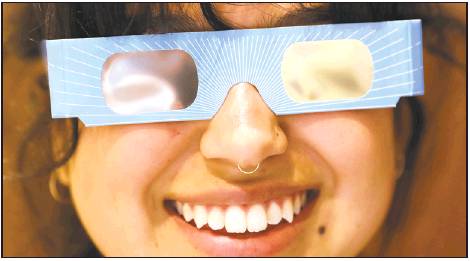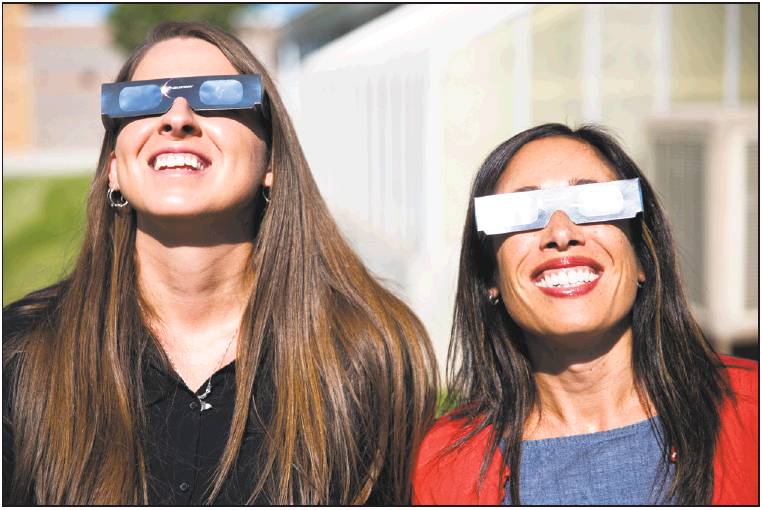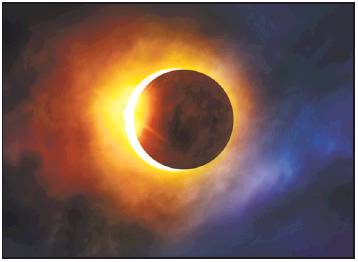EARTH
On the road to totality
Many journeying to see Monday’s eclipse
By John Burgeson
It’s about 660 miles from southwestern Connecticut to the path of totality of the solar eclipse, but that hasn’t cast a shadow over the scores of area people gearing up to travel for the cosmic event.
Along the Connecticut shoreline, the moon will appear to cover about two-thirds of the sun Monday afternoon. The maximum eclipse will be seen here at about 2:45 p.m. The moon will begin covering the sun at 1:24 p.m. and the show will be over at 4 o’clock. If you’re seeing a partial eclipse, you’ll need solar viewing glasses, which some local stores have begun selling; they’re also sold online. They block out over 99.999 percent of visible and ultraviolet light.
Many aren’t settling for seeing a partial eclipse; they’re journeying to a spot along the path of the moon’s shadow, which in the United States will extend from Oregon to South Carolina.
Counterintuitively, an eclipse’s shadow moves from west to east. Over the course of less than 2 hours, those in a narrow path through 14 states will experience more than two minutes of darkness in the middle of the day.
“We have about 20 people who are traveling to see it,” said Dan Wright of the Westport Astronomical Society. “Most of us will be in Beatrice, Nebraska, a couple of us will be in Alliance (Neb.) and two more will be in Kentucky working on a balloon experiment for NASA.”
In that balloon experiment, 54 teams of researchers and students will be releasing balloons along the path of totality. One of those involved in that effort will be Professor Jani Macari Pallis of the University of Bridgeport, who will be with a team near Hardin, Ky.
“We’ll have two balloons from Connecticut,” she said. “The payloads will be going up to about 100,000 feet, and they’ll be video streaming the eclipse live.”
Scientific opportunity
She said along with the video package, the balloons will carry a card — a “bacterial coupon” — with harmless bacteria.
“The idea is to see if we can replicate conditions on Mars, when the atmosphere high up cools in the moon’s shadow,” Pallis said. “We know that the sun will get blotted out about three times faster than in a sunset, so the atmosphere will be getting cold fast. How cold? We’ll have to find out.”
To that end, the teams will send weather balloons aloft, too, she said.
“The trick will be to release them so that they’ll stay in the shadow,” she said. “We’ll have to launch them over an hour ahead of time — they have to get up to about 80,000 feet at least.”
Pallis is doing the experiment along with students and professors from the University of Hartford. Students from Fairchild Wheeler Magnet High School in Bridgeport will participate, she said.
“It seemed like a no-brainer to include an aerospace magnet school,” Pallis said. “These students are very engaged. They’ve been here every morning for meetings and training. They’re writing procedures. Make no mistake, they are valued members of this team.”
She launched a test balloon on July 31 to check its flight characteristics.
“We’ve been doing flight predictions, but in Kentucky, it’s really hard to say where they will go,” Pallis said.
Room and board
The shadow’s path is only about 70 miles wide, and eclipse-watchers will want to get as close as possible to its center line to experience the longest period of totality. Standing on that line, one will experience about 2 minutes and 30 seconds of darkness; at the edge of the shadow, this will diminish to just a few seconds.
“I wish more people would travel to see it,” Wright said. “It’s something that’s so amazingly rare and beautiful.”
Not surprisingly, Nebraska has seen a 325 percent increase in hotel searches and Kansas has seen more than a 200 percent increase leading up to the eclipse. The The Oregon Department of Transportation expects the eclipse to be the biggest traffic event in the state’s history, drawing about 1 million people to the zone of totality.
If you’re thinking of staying in a motel in or near the shadow’s path, think again. Nearly all of the rooms are booked along the path and have been for months. Meanwhile, the little towns the dot the path of totality are bracing for an influx of what could be hundreds or even thousands of visitors who will be driving long distances to see the spectacle.
“We’ll be doing the best we can,” said the mayor of Hillsboro, Mo., Dennis K. Bradley. “There’s a college nearby that can handle a large number of people, but we’re limited on funds, so we can’t spend a lot of money — if it’s cloudy that day, not too many will be showing up.”
Bridgeport’s Discovery Museum, 4450 Park Ave., will celebrate “a day of safe and exciting solar eclipse viewing.”
The all-day event will begin at 10 a.m. with high-powered scopes modified to allow safe viewing of the sun.
The museum will be handing out solar glasses, and special activities will be taking place throughout the day.
The Westport Astronomical Society, 182 Bayberry Lane, Westport, will have an eclipse event, with telescopes fitted with solar filters and solar glasses available, too.


